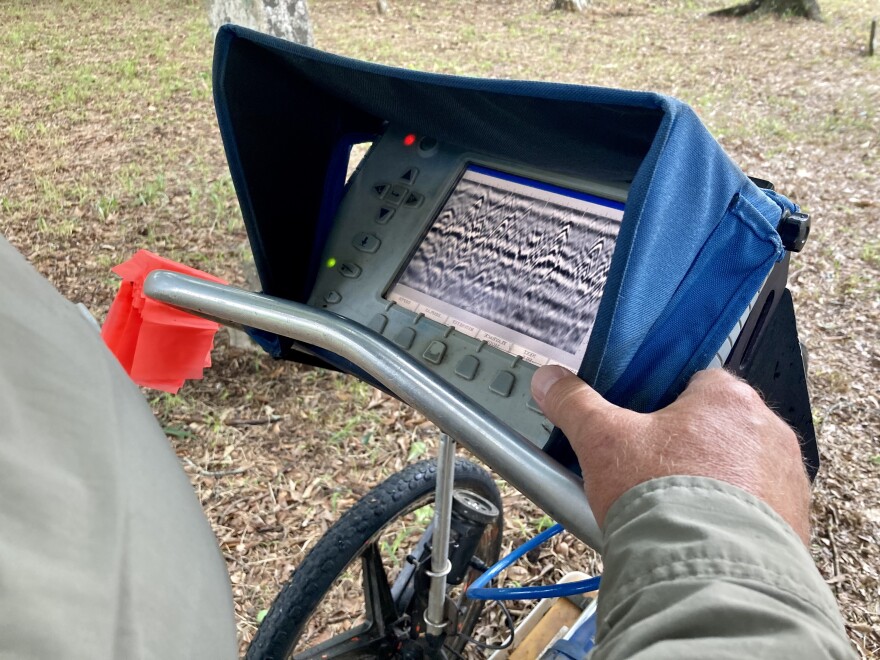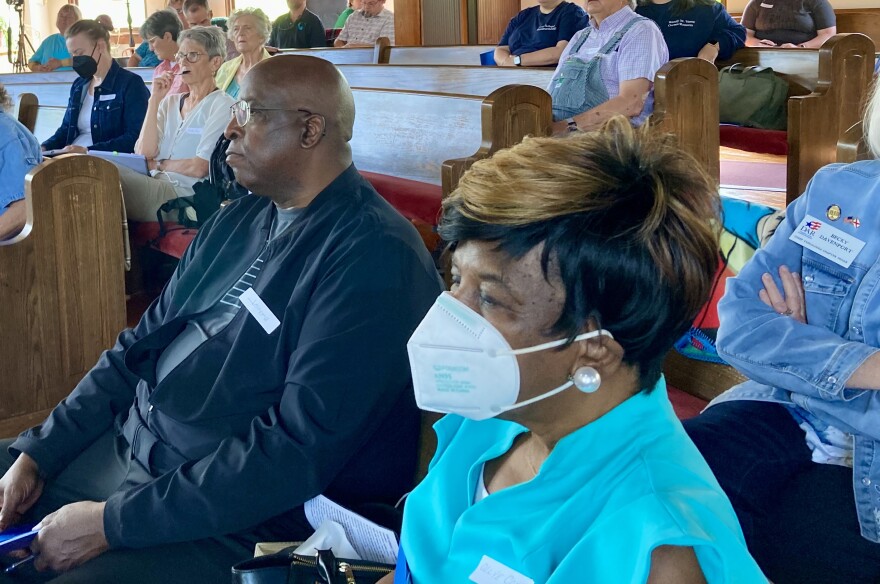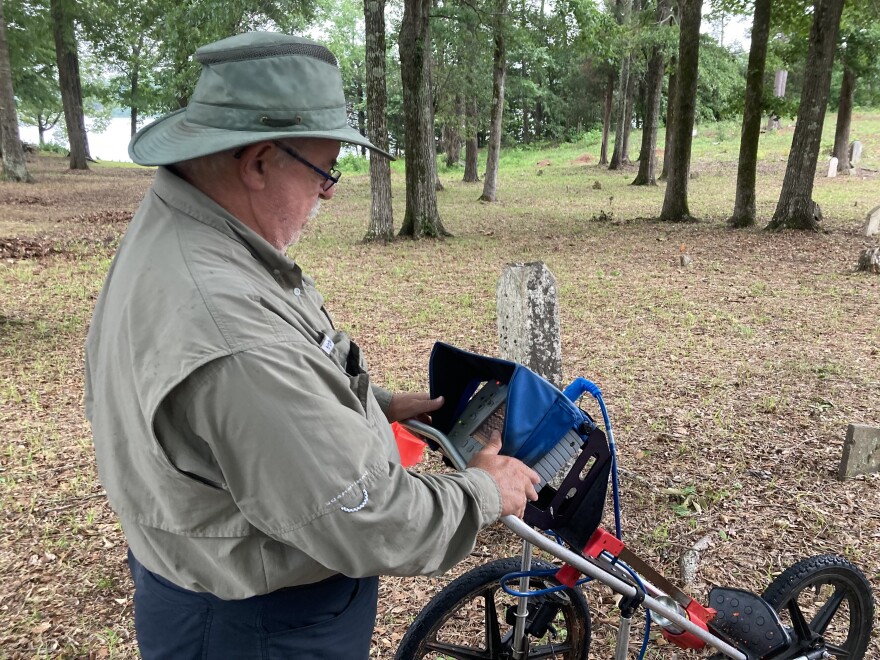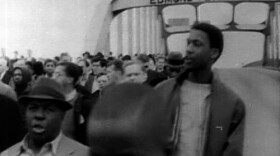Part 1 — "The 40 unmarked graves"
“I got all my equipment in the back of the Honda CRV. How’s that for efficiency and good engineering?” asked Len Strozier during a quiet morning in a wooded area on the Black Warrior River, north of Tuscaloosa. He's getting ready to go to work.

“It all scissors out like that,” he said. The scissoring refers to a collapsible rig about the size of a grocery store shopping cart. It has big black wheels, a box on top with buttons and a small view screen. There’s another box down below.
“Alright, this is ground penetrating radar machine. This is two GPS machines,” said Strozier.
A radar antenna that looks for airplanes typically points up. Strozier’s antenna looks down. What interests him lies underground…
It’s just a matter of putting it together,” quips Strozier. He uses his equipment to scan for things like buried water pipes that are leaking. That’s about thirty percent of what he does. Today is how he spends most of his time.
He’s looking for bodies.
“Just walking around, and there’s one right there. That’s a casketed burial,” said Strozier after working less than a minute. “Right now, I see an air pocket where a body was buried in the ground. As the body is placed in the ground. If it’s not embalmed, or protected with a vault, it all breaks down, It degrades…decomposes—including the wooden casket,” he observed.
Strozier runs Omega Mapping Services in Fortson, Georgia. APR news invited him to scan this two acre spot near Tuscaloosa. We’re at the Old Prewitt Slave Cemetery. It was set up in the 1820’s by John Welch Prewitt, a local plantation owner. The one unmarked grave Strozier found was just for starter. A more complete total came later.
“In less than thirty minutes, forty. Just walking around. I’ve seen forty burials out here,” said Strozier.

There’s a handful of tombstones and plain burial markers at Old Prewitt. Nowhere close to the number of graves Strozier found. This isn’t just an issue involving the dead. There are the living as well.
“My father drove us there,” said Patricia Kemp. “I was probably…maybe I want to say six or seven. Then, he’d drive to a place and he’d tell us what it is, or who they were. So, that’s what I remember.”
As an adult, Kemp did some research and she thinks some of her ancestors are buried at the Old Prewitt Slave Cemetery. By that time, the burial yard was disappearing as trees and scrub brush took over. At one point, Alabama listed Old Prewitt as one of the state's most endangered places.
“Knowing that that cemetery is there, and it is just dwindling away, it’s just being washed away. It’s just thrown away,” said Kemp. “It’s like taking my grandfather, my great grandfather, or father or my mother and knowing that they’re buried there, and just trashing them.”
Old Prewitt isn’t the only slave cemetery in Alabama.
Researchers from the University of Alabama in Huntsville say up to two hundred slaves rest here, at the Mount Paran Cemetery just south of the Tennessee border. That doesn’t count the estimated ten thousand enslaved people believed to be buried nearby in Huntsville.
“I was able to find my great great grandfather listed,” said Olley Ballard. She thinks that ancestor was one of them. He was enslaved in Huntsville in 1842.

“He was on the Longwood Plantation,” she said. “And, we found his name, and then his son’s name…Caswell, and Caswell, junior. And, we were able to follow him to his death.”
But, that doesn’t mean Ballard can visit her great, great grandfather’s grave site. She’s not sure where that is. There are oral histories told by family members and the few records Ballard could find-- but that’s all. And if you’ve never heard a story like that before, we met someone who has.
“All the time, all the time. That is…that is…one of the most outrageous,” said Ethel Alexander. She’s with the Birmingham African American Genealogy Group, the largest of its kind in the state. She says even if family members find the cemetery where their enslaved ancestors are buried, questions often remain
“They may not see anything but a rock,” Alexander observed. “They may not see nothing but tree. You know, you’re not going to be to say ‘oh, there’s my grandfather…great, great, great slave.’”
“Every day you pick up the paper, there’s a new slave cemetery. And, a slave cemetery where slaves were just thrown with no head stones,” said Lorayn Allen. In case you were thinking that slave cemeteries are just an issue in the south, they’re not. Allen is working to preserve a burial site in Bridgewater, New Jersey. Allen says convincing her grandchildren that an estimated twelve thousand slaves were in the Garden State just before the Civil War is tough
“They call me Mimi,” said Allen. “They say ‘Mimi, for God’s sake, we live in Somerville, New Jersey.’ I say, do you realize they still have Ku Klux Klan ramblings in certain areas over here. Everything that happened in the South happened here in the North. Make no mistake about it.”
Back at the Old Prewitt Slave Cemetery in Northport, Alabama-- Len Strozier has been doing some thinking. His preliminary scan with ground penetrating radar showed forty unmarked graves. So, now he’s ready to make an educated guess about what he calls unmarks.
“I would say there would be at least two hundred unmarks, in this acre and a half, at least that, without a doubt,” said Strozier.
Each of these unknown burial sites can represent a mystery to a family somewhere. But, you don’t have to have an ancestor buried at Old Prewitt to be involved. For example…Tuscaloosa native and former world heavyweight boxing championship Deontay Wilder. His connection to the Old Prewitt Slave Cemetery is in part 2.










